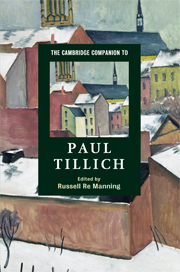Book contents
- Frontmatter
- Part I Standing within the theological circle
- 1 Tillich’s life and works
- 2 Tillich as systematic theologian
- 3 Tillich on God
- 4 Tillich’s Christology
- 5 Tillich’s theology of the concrete spirit
- 6 Faith (and religion)
- 7 ‘First, read my sermons’ Tillich as preacher
- Part II Theology of culture
- Part III Tillich in dialogue
- Bibliography
- Index
7 - ‘First, read my sermons’ Tillich as preacher
from Part I - Standing within the theological circle
Published online by Cambridge University Press: 28 May 2009
- Frontmatter
- Part I Standing within the theological circle
- 1 Tillich’s life and works
- 2 Tillich as systematic theologian
- 3 Tillich on God
- 4 Tillich’s Christology
- 5 Tillich’s theology of the concrete spirit
- 6 Faith (and religion)
- 7 ‘First, read my sermons’ Tillich as preacher
- Part II Theology of culture
- Part III Tillich in dialogue
- Bibliography
- Index
Summary
When they appeared in German translation, Tillich's American sermons - The Shaking of the Foundations, The New Being and The Eternal Now - were given the revealing subtitle Religiöse Reden, or 'religious speeches'. In his 1923 System of the Sciences, Tillich placed preaching ('religious speech') within rhetoric as a part of practical theology: 'rhetoric on theonomous ground' (GW I, 188). Tillich's homiletic theory is firmly embedded in his understanding of systematic theology; even as a preacher, Tillich remained above all a systematic theologian. His sermons, in much the same way as his famous method of correlation, are determined by his insistence upon posing with all seriousness the question of the relevance of the Christian message to his contemporary society. Tillich did not immediately arrive at this 'cultural-theological' understanding of the task of preaching. In his Kirchliche Apologetik of 1912-13 Tillich challenged apologetic theology to be conscious of the contemporary religious situation, characterized as the dominance of autonomous spiritual forms that had become foreign to the churches and to Christianity. By contrast, he characterized sermons as the presentation (Darlegung) of Christian teachings to the conscious members of that community (GW XIII, 44). However, in the course of the 1920s Tillich abandoned this dualism between apologetics and sermons. In his 1928 lecture 'The Protestant Message and the Man of Today' Tillich characterized his contemporaries as living in a situation of an uncertain autonomy (GW VII, 70-83; ProtE, 192-205).
- Type
- Chapter
- Information
- The Cambridge Companion to Paul Tillich , pp. 105 - 120Publisher: Cambridge University PressPrint publication year: 2009
- 1
- Cited by



